Time-Optimal Asymmetric S-Curve Trajectory Planning of Redundant Manipulators under Kinematic Constraints
Abstract
:1. Introduction
- The end-effector trajectory is essentially designed by the kinematic constraints of joint actuators rather than the operational-space constraints, which are used for the velocity scheduling of CNC machines [37].
- This study provides an exact velocity-limit curve of the end-effector, not conservative as BLA described in [35]. It helps to explore the maximum capabilities within the kinematic constraints of robots, generating time-optimal trajectories to improve productivity.
- The meta-heuristic WOA is adopted to find the time-optimal solution. The optimization-based trajectory planning method can flexibly handle complex constraints of the redundant manipulator and avoid solving the deceleration point.
- The jerk-limited S-shaped velocity profile is categorized into four types depending on the existence of acceleration of deceleration blocks. The WOA-based asymmetric S-curve velocity Acc/Dec can be automatically adjusted for different arc lengths and the starting and ending velocities of a path.
2. Optimization of the Seven-Phase Asymmetrical S-Curve Acc/Dec Algorithm
2.1. Basis of the Seven-Phase Asymmetrical S-Curve
2.2. Parameters Design of the Seven-Phase Asymmetrical S-Curve Acc/Dec
2.3. Principle of the WOA Algorithm
- Encircling prey.
- 2.
- Bubble-net attack approach (exploitation).
- 3.
- Search for prey (exploration).
2.4. WOA-Based Asymmetrical S-Curve Acc/Dec
| Algorithm 1. Pseudo-code of WOA-based asymmetrical S-curve Acc/Dec | |
| Input: (1) Arc length L, start velocity vs, and end velocity ve; (2) S-curve type. Output: The best search agent X*. | |
| 1: | Set the swarm size Ns, maximum iterations Niter, and the weight factor |
| 2: | Initialize the population Xr of whales based on the S-curve type |
| 3: | Evaluate the fitness of each search agent using Equation (25) |
| 4: | Set X* as the best search agent |
| 5: | while (δ < Niter) |
| 6: | for each search agent |
| 7: | Update a, A, C, l, and pr |
| 8: | if (pr < 0.5) |
| 9: | if (|A| < 1) |
| 10: | Calculate a new position of the current search agent using the first formula in Equation (21) |
| 11: | otherwise (|A| ≥ 1) |
| 12: | Select a random search agent (Xrand) |
| 13: | Calculate a new position of the current search agent using Equation (23) |
| 14: | end if |
| 15: | otherwise (pr > 0.5) |
| 16: | Calculate a new position of the current search agent using the second formula in Equation (21) |
| 17: | end if |
| 18: | Check if the new position respects the kinematic constraints |
| 19: | If not, discard it. Otherwise, update the current search agent to the new position |
| 20: | end for |
| 21: | Calculate the fitness of each search agent using Equation (25) |
| 22: | Update X* if there is a better solution |
| 23: | δ = δ + 1 |
| 24: | end while |
| 25: | return X* |
- Initialize the population of whales based on the S-curve type.
- 2.
- Evaluate the fitness value of each search agent.
- 3.
- Determine whether the constraints are satisfied.
3. Time-Optimal Asymmetric S-Curve Trajectory for Redundant Manipulators
3.1. Trajectory Model Based on the NURBS Interpolation Technique
3.2. Kinematic Constraint Handling
3.3. Time-Optimal Asymmetric S-Curve for Multiple NURBS Segments
| Algorithm 2. Time-optimal asymmetric S-curve trajectory generation | |
| Input: VLC of the end-effector along the specified path. Output: The end-effector desired motion profile. | |
| 1: | Identify the critical points at local minimum points of VLC in Equation (38) |
| 2: | Split the NURBS curve into Nγ segments at critical points |
| 3: | Estimate the arc length of each NURBS segment using Equations (29)–(32) |
| 4: | Derive the start and end velocities of each segment using the VLC in Equation (38) |
| 5: | for each NURBS segment |
| 6: | Calculate the reference length using Equations (7) and (8) |
| 7: | if Lγ ≥ Lref,γ |
| 8: | Call Algorithm 1 |
| 9: | Calculate the jerk of each phase of the S-curve using Equation (9) |
| 10: | otherwise Lγ < Lref,γ |
| 11: | Determine whether the acceleration and deceleration blocks exist |
| 12 | if vs,γ < ve,γ |
| 13: | The deceleration block does not exist |
| 14: | Set T5,γ = T6,γ = T7,γ = 0 |
| 15: | Call Algorithm 1 |
| 16: | Calculate the jerk of each phase of the S-curve using Equation (11) |
| 17: | otherwise vs,γ > ve,γ |
| 18: | The acceleration block does not exist |
| 19: | Set T1,γ = T2,γ = T3,γ = 0 |
| 20: | Call Algorithm 1 |
| 21: | Calculate the jerk of each phase of the S-curve using Equation (13) |
| 22: | otherwise vs,γ = ve,γ |
| 23: | Acceleration and deceleration blocks do not exist |
| 24: | Set T1,γ = T2,γ = T3,γ = T5,γ = T6,γ = T7,γ = 0 and T4,γ = Lγ/vs,γ |
| 25: | Set the jerk of each phase of the S-curve as zero |
| 26: | end if |
| 27: | end if |
| 28: | Calculate the acceleration of each phase using Equation (3) |
| 29: | Calculate the velocity of the γth NURBS segment by integrating acceleration |
| 30: | Determine the interpolation parameter u using Equation (28) |
| 31: | Determine the NURBS path using Equations (26) and (27) |
| 32: | end for |
| 33: | Derive the asymmetric S-curve trajectory |
4. Simulation
5. Experimental Results
6. Conclusions
Author Contributions
Funding
Institutional Review Board Statement
Informed Consent Statement
Data Availability Statement
Conflicts of Interest
Appendix A
Appendix B
| Items | Parameters |
|---|---|
| Degree: p | 2 |
| Knot vector: U1×12 | 0, 0, 0, 0.25, 0.25, 0.50, 0.50, 0.75, 0.75, 1.00, 1.00, 1.00 |
| Weights: ω1×9 | 1.00, 10.00, 1.00, 10.00, 1.00, 10.00, 1.00, 10.00, 1.00 |
| Control points: d9×3(m) | (0.70, −0.15, 1.00); (0.70, 0, 1.10); (0.70, 0.15, 1.00); (0.70, 0.30, 0.90); (0.70, 0.15, 0.80); (0.70, 0, 0.70); (0.70, −0.15, 0.80); (0.70, −0.30, 0.90); (0.70, −0.15, 1.00); |
| Items | Parameters |
|---|---|
| Degree: p | 2 |
| Knot vector: U1×55 | 0, 0, 0, 0, 0.0083, 0.0150, 0.0361, 0.0855, 0.1293, 0.1509, 0.1931, 0.2273, 0.2435, 0.2561, 0.2692, 0.2889, 0.3170, 0.3316, 0.3482, 0.3553, 0.3649, 0.3837, 0.4005, 0.4269, 0.4510, 0.4660, 0.4891, 0.5000, 0.5109, 0.5340, 0.5489, 0.5731, 0.5994, 0.6163, 0.6351, 0.6447, 0.6518, 0.6683, 0.6830, 0.7111, 0.7307, 0.7439, 0.7565, 0.7729, 0.8069, 0.8491, 0.8707, 0.9145, 0.9639, 0.9850, 0.9917, 1, 1, 1, 1 |
| Weights: ω1×55 | 1.00, 1.00, 1.00, 1.20, 1.00, 1.00, 1.00, 1.00, 1.00, 1.00, 1.00, 2.00, 1.00, 1.00, 5.00, 3.00, 1.00, 1.10, 1.00, 1.00, 1.00, 1.00, 1.00, 1.00, 1.00, 1.00, 1.00, 1.00, 1.00, 1.00, 1.00, 1.00, 1.00, 1.10, 1.00, 3.00, 5.00, 1.00, 1.00, 2.00, 1.00, 1.00, 1.00, 1.00, 1.00, 1.00, 1.00, 1.20, 1.00, 1.00, 1.00 |
| Control points: d55×3(m) | (0.700, 0, 1.009); (0.700, 0.004, 1.009); (0.700, 0.006, 0.998); (0.700, 0.009, 0.980); (0.700, 0.060, 1.005); (0.700, 0.093, 1.034); (0.700, 0.144, 1.068); (0.700, 0.206, 1.055); (0.700, 0.184, 0.990); (0.700, 0.160, 0.960); (0.700, 0.152, 0.922); (0.700, 0.116, 0.935); (0.700, 0.150, 0.914); (0.700, 0.140, 0.882); (0.700, 0.115, 0.862); (0.700, 0.136, 0.819); (0.700, 0.106, 0.837); (0.700, 0.101, 0.858); (0.700, 0.086, 0.834); (0.700, 0.063, 0.850); (0.700, 0.039, 0.867); (0.700, 0.022, 0.888); (0.700, 0.005, 0.945); (0.700, 0.010, 0.900); (0.700, 0.021, 0.879); (0.700, 0, 0.860); (0.700, −0.021, 0.879); (0.700, −0.010, 0.900); (0.700, −0.005, 0.945); (0.700, −0.022, 0.888); (0.700, −0.039, 0.867); (0.700, −0.063, 0.850);(0.700, −0.086, 0.834); (0.700, −0.101, 0.858); (0.700, −0.106, 0.837); (0.700, −0.136, 0.819); (0.700, −0.115, 0.862); (0.700, −0.140, 0.882); (0.700, −0.150, 0.914); (0.700, −0.116, 0.935); (0.700, −0.152, 0.922); (0.700, −0.160, 0.960); (0.700, −0.184, 0.990); (0.700, −0.206, 1.055); (0.700, −0.144, 1.068); (0.700, −0.093, 1.034); (0.700, −0.060, 1.005); (0.700, −0.009, 0.980); (0.700, −0.006, 0.998); (0.700, −0.004, 1.009); (0.700, 0, 1.009); |
References
- Ji, S.; Lei, L.; Zhao, J.; Lu, X.; Gao, H. An adaptive real-time NURBS curve interpolation for 4-axis polishing machine tool. Robot. Comput.-Integr. Manuf. 2021, 67, 102025. [Google Scholar] [CrossRef]
- Tsai, M.-S.; Nien, H.-W.; Yau, H.-T. Development of an integrated look-ahead dynamics-based NURBS interpolator for high precision machinery. Comput.-Aided Des. 2008, 40, 554–566. [Google Scholar] [CrossRef]
- Lee, A.-C.; Lin, M.-T.; Pan, Y.-R.; Lin, W.-Y. The feedrate scheduling of NURBS interpolator for CNC machine tools. Comput.-Aided Des. 2011, 43, 612–628. [Google Scholar] [CrossRef]
- Wu, G.; Zhao, W.; Zhang, X. Optimum time-energy-jerk trajectory planning for serial robotic manipulators by reparameterized quintic NURBS curves. Proc. Inst. Mech. Eng. Part C-J. Mech. Eng. Sci. 2021, 235, 4382–4393. [Google Scholar] [CrossRef]
- Wang, W.; Hu, C.; Zhou, K.; He, S.; Zhu, L. Local asymmetrical corner trajectory smoothing with bidirectional planning and adjusting algorithm for CNC machining. Robot. Comput.-Integr. Manuf. 2021, 68, 102058. [Google Scholar] [CrossRef]
- He, S.; Yan, C.; Deng, Y.; Lee, C.-H.; Zhou, X. A tolerance constrained G(2) continuous path smoothing and interpolation method for industrial SCARA robots. Robot. Comput.-Integr. Manuf. 2020, 63, 101907. [Google Scholar] [CrossRef]
- Sun, Y.W.; Jia, J.J.; Xu, J.T.; Chen, M.S.; Niu, J.B. Path, feedrate and trajectory planning for free-form surface machining: A state-of-the-art review. Chin. J. Aeronaut. 2022, 35, 12–29. [Google Scholar] [CrossRef]
- Montalvo, V.; Estevez-Ben, A.A.; Rodriguez-Resendiz, J.; Macias-Bobadilla, G.; Mendiola-Santibanez, J.D.; Camarillo-Gomez, K.A. FPGA-Based Architecture for Sensing Power Consumption on Parabolic and Trapezoidal Motion Profiles. Electronics 2020, 9, 1301. [Google Scholar] [CrossRef]
- Biagiotti, L.; Melchiorri, C. Trajectory generation via FIR filters: A procedure for time-optimization under kinematic and frequency constraints. Control Eng. Pract. 2019, 87, 43–58. [Google Scholar] [CrossRef]
- Besset, P.; Béarée, R. FIR filter-based online jerk-constrained trajectory generation. Control Eng. Pract. 2017, 66, 169–180. [Google Scholar] [CrossRef] [Green Version]
- Ha, C.-W.; Lee, D. Analysis of Embedded Prefilters in Motion Profiles. IEEE Trans. Ind. Electron. 2018, 65, 1481–1489. [Google Scholar] [CrossRef]
- Macfarlane, S.; Croft, E.A. Jerk-bounded manipulator trajectory planning: Design for real-time applications. IEEE Trans. Robot. Autom. 2003, 19, 42–52. [Google Scholar] [CrossRef] [Green Version]
- Li, H.Z.; Le, M.D.; Gong, Z.M.; Lin, W. Motion Profile Design to Reduce Residual Vibration of High-Speed Positioning Stages. IEEE-ASME Trans. Mechatron. 2009, 14, 264–269. [Google Scholar]
- Liang, F.; Yan, G.; Fang, F. Global time-optimal B-spline feedrate scheduling for a two-turret multi-axis NC machine tool based on optimization with genetic algorithm. Robot. Comput.-Integr. Manuf. 2022, 75, 102308. [Google Scholar] [CrossRef]
- Liu, H.; Lai, X.; Wu, W. Time-optimal and jerk-continuous trajectory planning for robot manipulators with kinematic constraints. Robot. Comput.-Integr. Manuf. 2013, 29, 309–317. [Google Scholar] [CrossRef]
- Mercy, T.; Jacquod, N.; Herzog, R.; Pipeleers, G. Spline-Based Trajectory Generation for CNC Machines. IEEE Trans. Ind. Electron. 2019, 66, 6098–6107. [Google Scholar] [CrossRef]
- Huang, J.; Hu, P.; Wu, K.; Zeng, M. Optimal time-jerk trajectory planning for industrial robots. Mech. Mach. Theory 2018, 121, 530–544. [Google Scholar] [CrossRef]
- Ma, J.W.; Gao, S.; Yan, H.T.; Lv, Q.; Hu, G.Q. A new approach to time-optimal trajectory planning with torque and jerk limits for robot. Robot. Auton. Syst. 2021, 140, 103744. [Google Scholar] [CrossRef]
- Jahanpour, J.; Alizadeh, M.R. A novel acc-jerk-limited NURBS interpolation enhanced with an optimized S-shaped quintic feedrate scheduling scheme. Int. J. Adv. Manuf. Technol. 2015, 77, 1889–1905. [Google Scholar] [CrossRef]
- Lin, J.; Somani, N.; Hu, B.; Rickert, M.; Knoll, A. An Efficient and Time-Optimal Trajectory Generation Approach for Waypoints Under Kinematic Constraints and Error Bounds. In Proceedings of the 2018 IEEE/RSJ International Conference on Intelligent Robots and Systems (IROS), Madrid, Spain, 1–5 October 2018; pp. 5869–5876. [Google Scholar]
- Wang, F.; Wu, Z.; Bao, T. Time-Jerk optimal Trajectory Planning of Industrial Robots Based on a Hybrid WOA-GA Algorithm. Processes 2022, 10, 1014. [Google Scholar] [CrossRef]
- Fang, Y.; Hu, J.; Liu, W.; Shao, Q.; Qi, J.; Peng, Y. Smooth and time-optimal S-curve trajectory planning for automated robots and machines. Mech. Mach. Theory 2019, 137, 127–153. [Google Scholar] [CrossRef]
- Lu, T.-C.; Chen, S.-L.; Yang, E.C.-Y. Near Time-Optimal S-Curve Velocity Planning for Multiple Line Segments Under Axis Constraints. IEEE Trans. Ind. Electron. 2018, 65, 9582–9592. [Google Scholar] [CrossRef]
- Biagiotti, L.; Melchiorri, C. FIR filters for online trajectory planning with time- and frequency-domain specifications. Control Eng. Pract. 2012, 20, 1385–1399. [Google Scholar] [CrossRef] [Green Version]
- Biagiotti, L.; Melchiorri, C. Optimization of Generalized S-Curve Trajectories for Residual Vibration Suppression and Compliance with Kinematic Bounds. IEEE-ASME Trans. Mechatron. 2021, 26, 2724–2734. [Google Scholar] [CrossRef]
- Hassan, G.; Gouttefarde, M.; Chemori, A.; Hervé, P.E.; Rafei, M.E.; Francis, C.; Sallé, D. Time-Optimal Pick-and-Throw S-Curve Trajectories for Fast Parallel Robots. IEEE/ASME Trans. Mechatron. 2022, 27, 4707–4717. [Google Scholar] [CrossRef]
- Lee, D.; Ha, C.-W. Optimization Process for Polynomial Motion Profiles to Achieve Fast Movement with Low Vibration. IEEE Trans. Control Syst. Technol. 2020, 28, 1892–1901. [Google Scholar] [CrossRef]
- Fang, Y.; Qi, J.; Hu, J.; Wang, W.; Peng, Y. An approach for jerk-continuous trajectory generation of robotic manipulators with kinematical constraints. Mech. Mach. Theory 2020, 153, 103957. [Google Scholar] [CrossRef]
- Li, H.Z. A jerk-constrained asymmetric motion profile for high-speed motion stages to reduce residual vibration. Int. J. Comput. Appl. Technol. 2016, 53, 149–156. [Google Scholar] [CrossRef] [Green Version]
- Zhu, Q.; Jin, Y.; Zhu, Y. An optimized cosine jerk motion profile with higher efficiency and flexibility. Assem. Autom. 2022, 42, 350–360. [Google Scholar] [CrossRef]
- Rew, K.H.; Kim, K.S. A Closed-Form Solution to Asymmetric Motion Profile Allowing Acceleration Manipulation. IEEE Trans. Ind. Electron. 2010, 57, 2499–2506. [Google Scholar] [CrossRef]
- Acharya, P.; Nguyen, K.-D.; La, H.M.; Liu, D.; Chen, I.M. Nonprehensile Manipulation:A Trajectory-Planning Perspective. IEEE-ASME Trans. Mechatron. 2021, 26, 527–538. [Google Scholar]
- Kornmaneesang, W.; Chen, S.-L. Time-optimal feedrate scheduling with actuator constraints for 5-axis machining. Int. J. Adv. Manuf. Technol. 2022, 119, 6789–6807. [Google Scholar] [CrossRef]
- Bai, Y.; Chen, X.; Sun, H.; Yang, Z. Time-Optimal Freeform S-Curve Profile Under Positioning Error and Robustness Constraints. IEEE/ASME Trans. Mechatron. 2018, 23, 1993–2003. [Google Scholar] [CrossRef]
- Trigatti, G.; Boscariol, P.; Scalera, L.; Pillan, D.; Gasparetto, A. A new path-constrained trajectory planning strategy for spray painting robots—Rev.1. Int. J. Adv. Manuf. Technol. 2018, 98, 2287–2296. [Google Scholar] [CrossRef]
- Mirjalili, S.; Lewis, A. The Whale Optimization Algorithm. Adv. Eng. Softw. 2016, 95, 51–67. [Google Scholar] [CrossRef]
- Du, X.; Huang, J.; Zhu, L.-M. A complete S-shape feed rate scheduling approach for NURBS interpolator. J. Comput. Des. Eng. 2015, 2, 206–217. [Google Scholar] [CrossRef] [Green Version]
- Gharehchopogh, F.S.; Gholizadeh, H. A comprehensive survey: Whale Optimization Algorithm and its applications. Swarm Evol. Comput. 2019, 48, 1–24. [Google Scholar] [CrossRef]
- Waltz, R.A.; Morales, J.L.; Nocedal, J.; Orban, D. An interior algorithm for nonlinear optimization that combines line search and trust region steps. Math. Program. 2006, 107, 391–408. [Google Scholar] [CrossRef]
- Liu, T.; Zhu, M.; Chen, L. Trajectory Planning for Hyper-Redundant Manipulators Based on Lie Theory. In Proceedings of the 2021 IEEE International Conference on Real-time Computing and Robotics (RCAR), Xining, China, 15–19 July 2021; pp. 63–68. [Google Scholar]
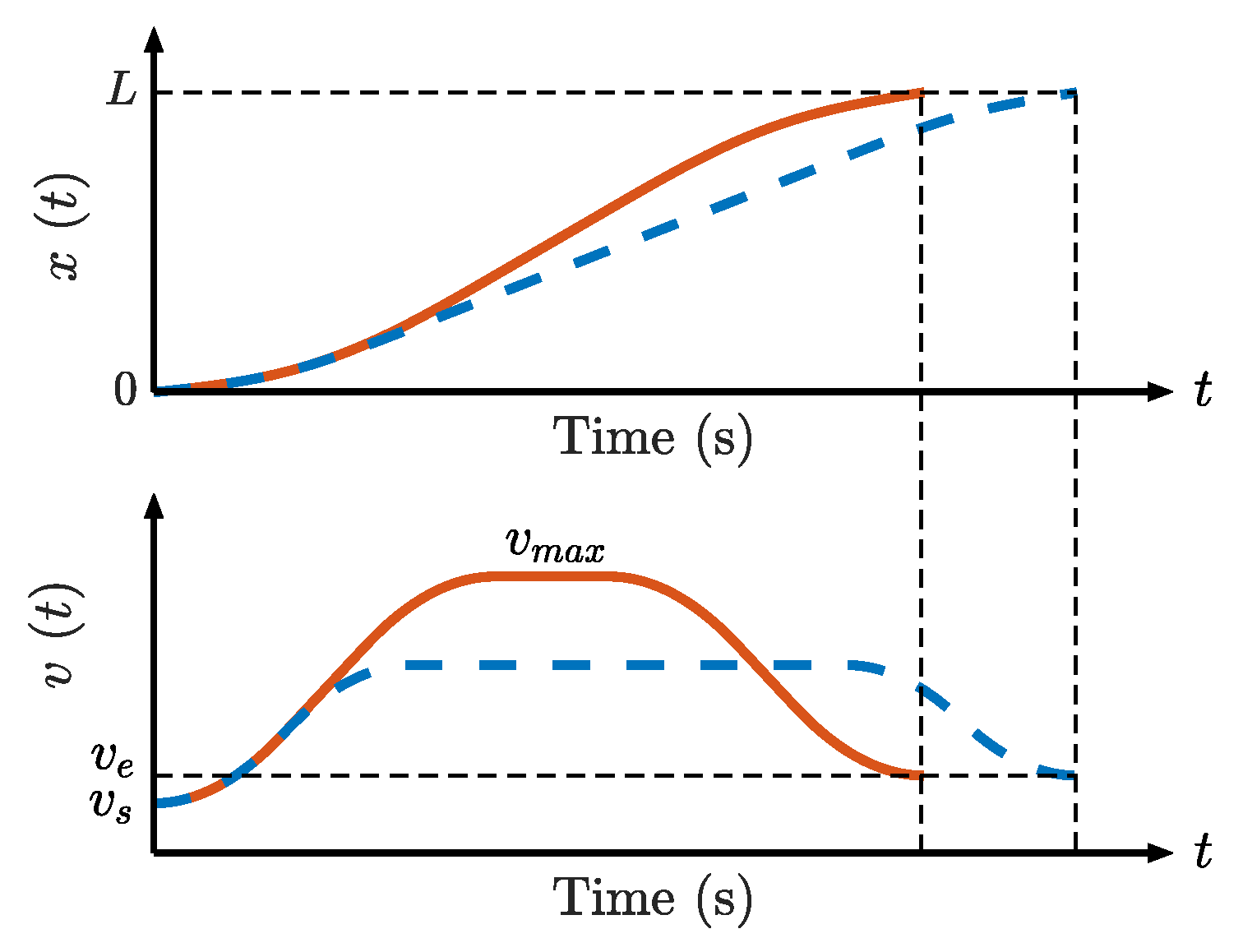

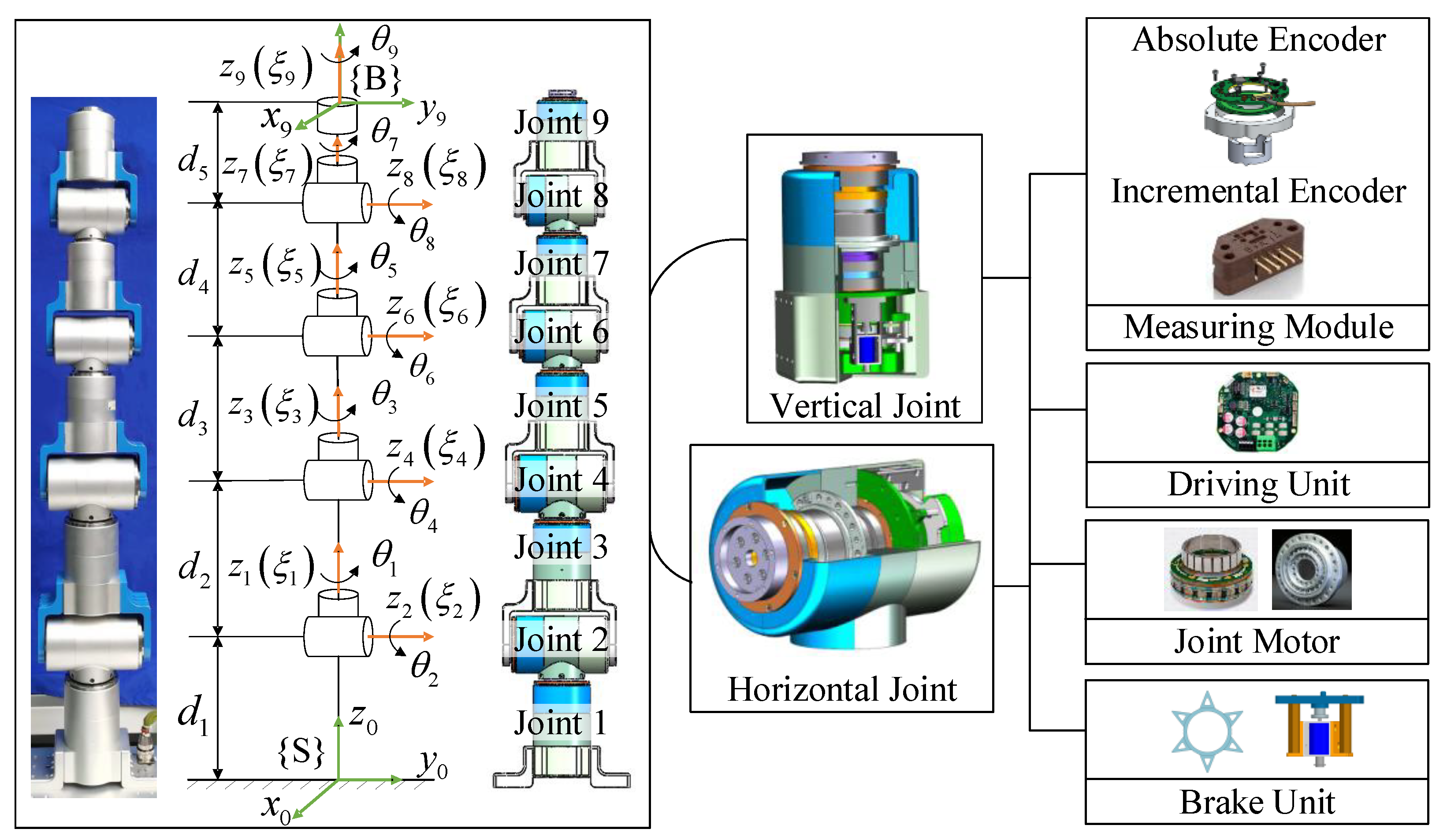

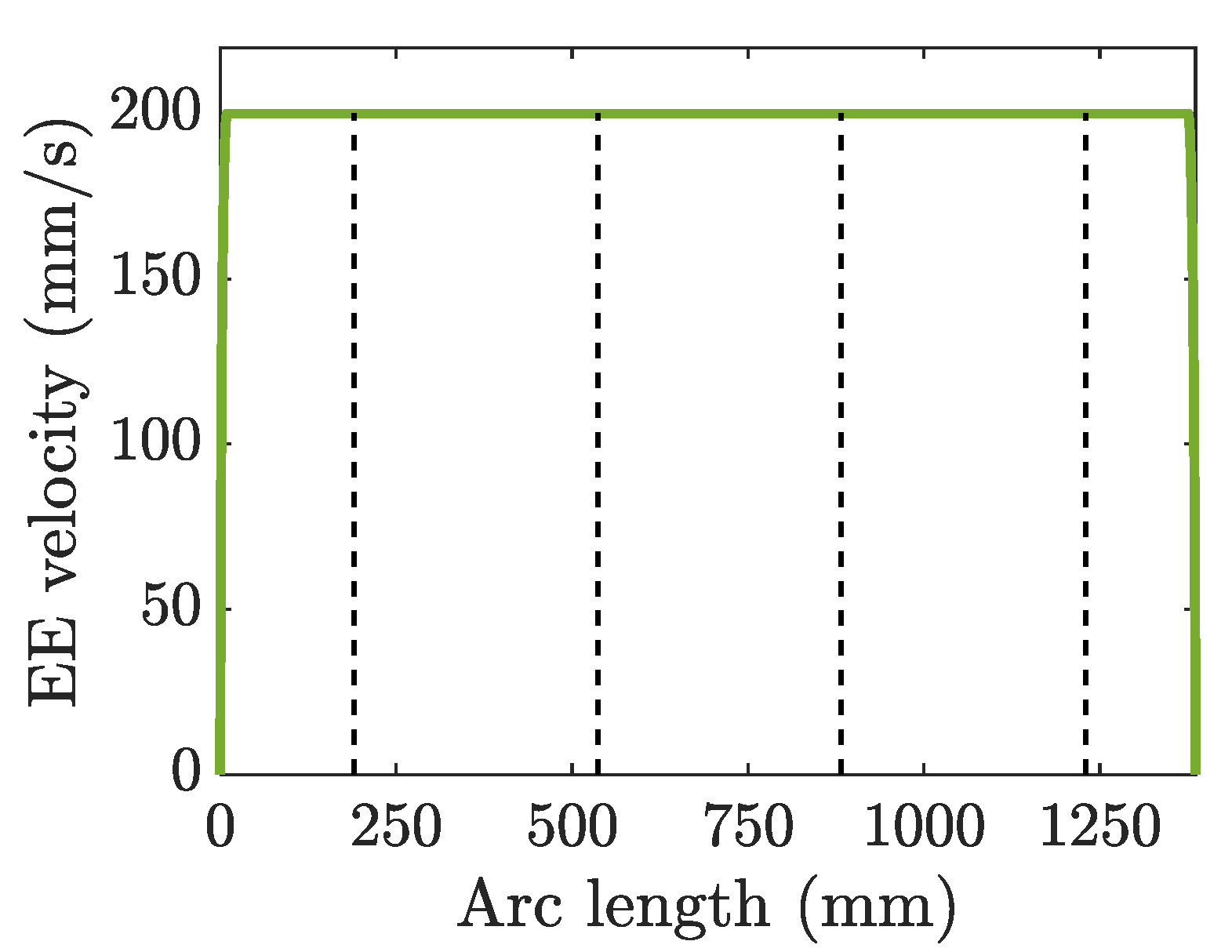

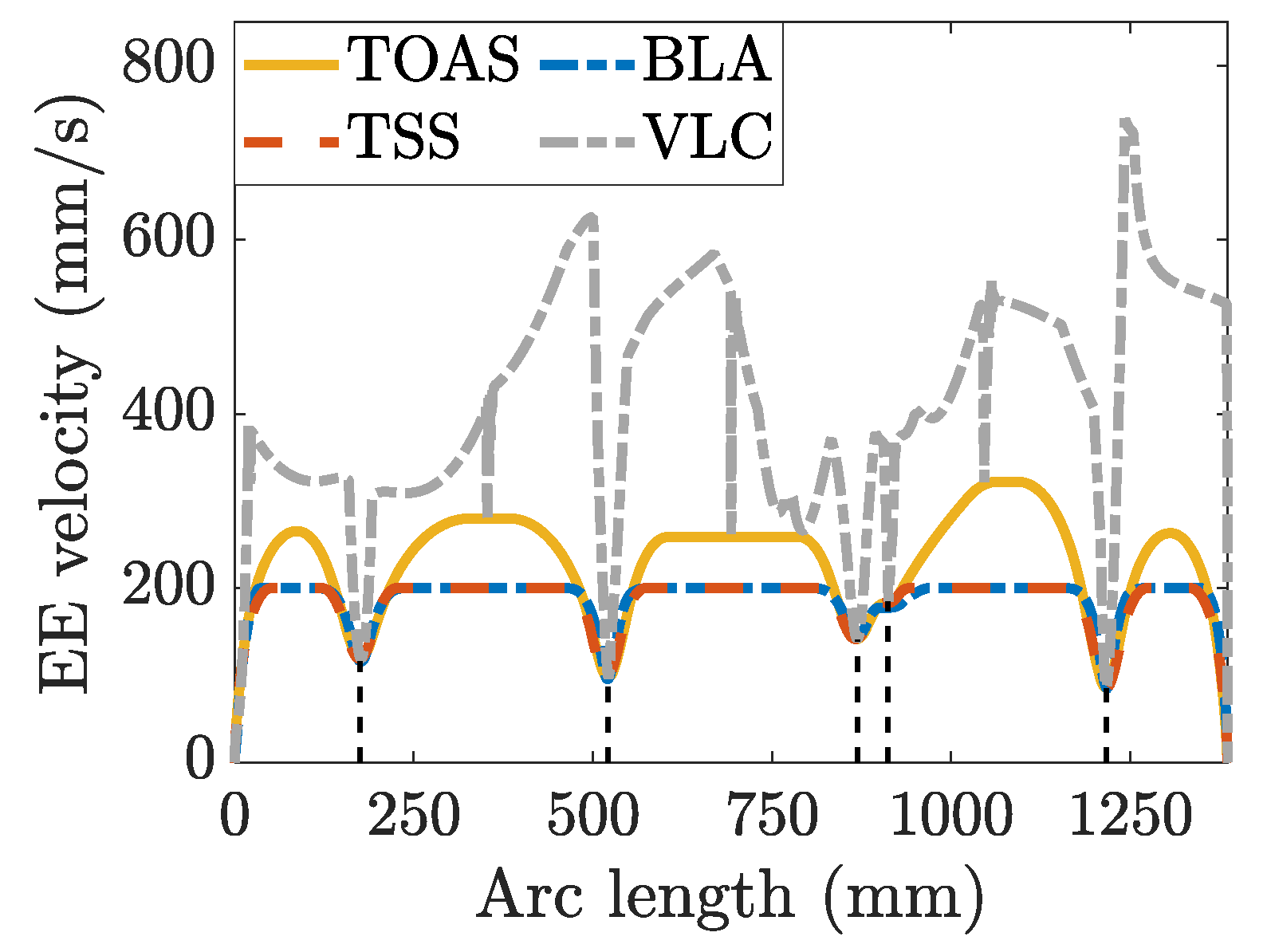
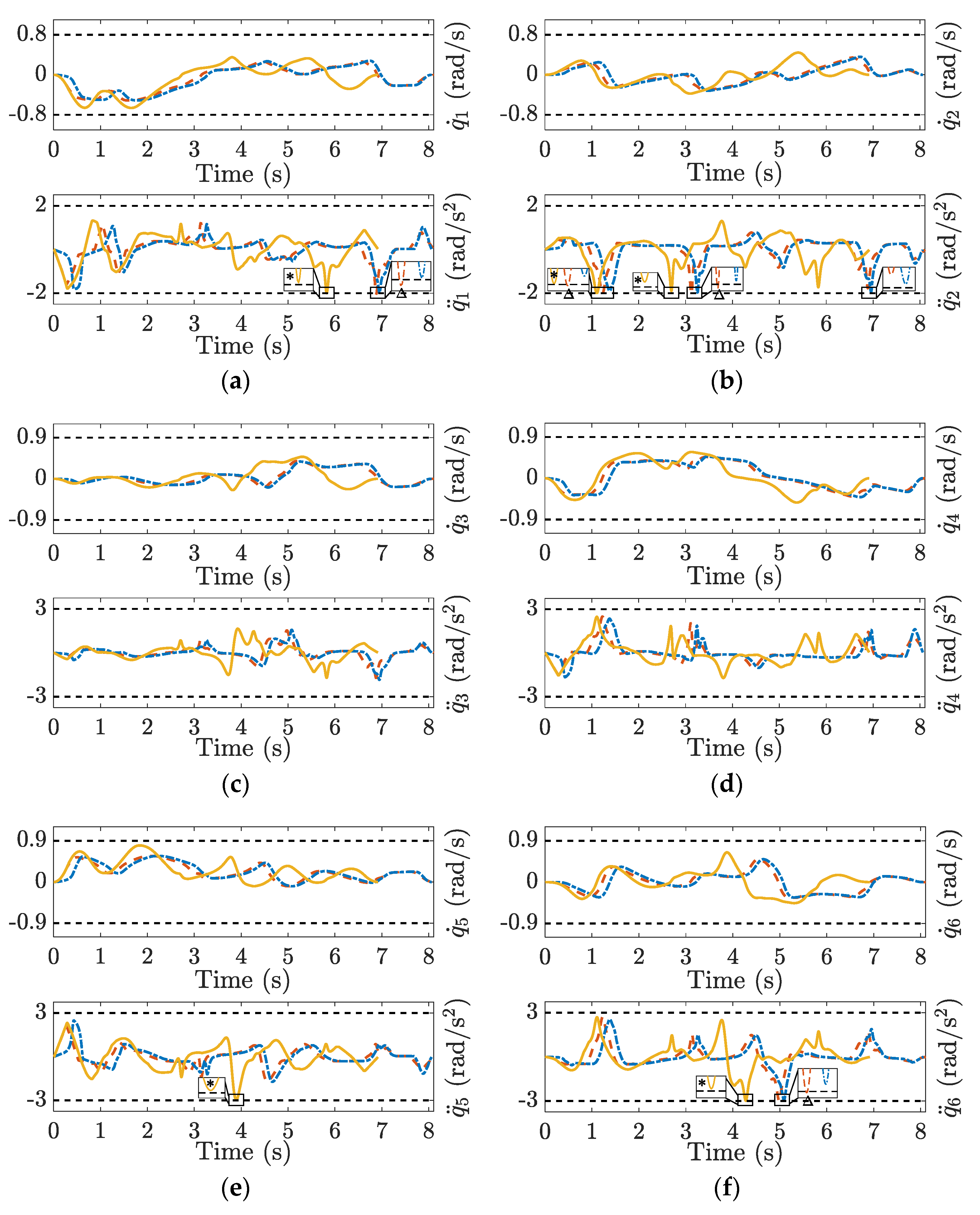


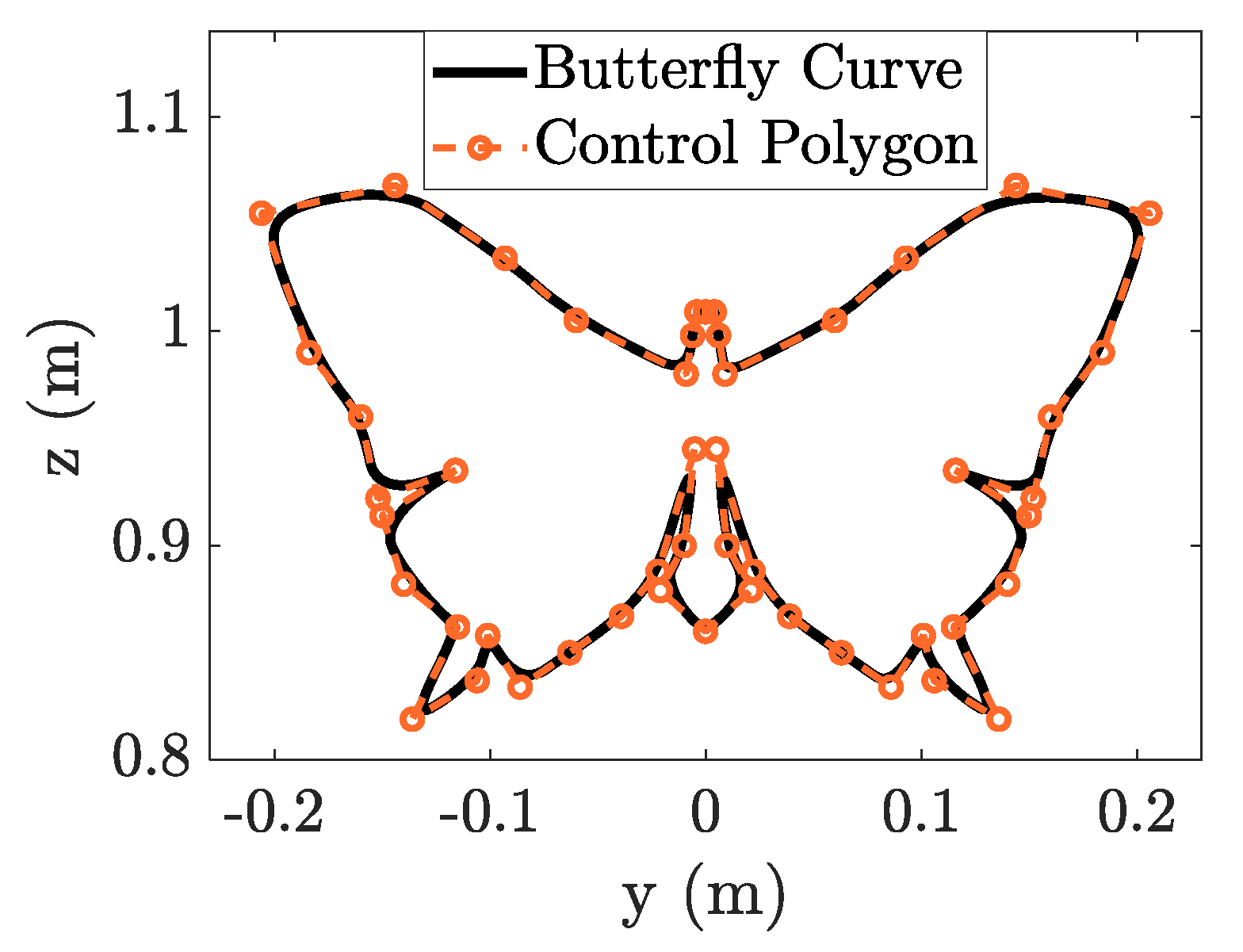
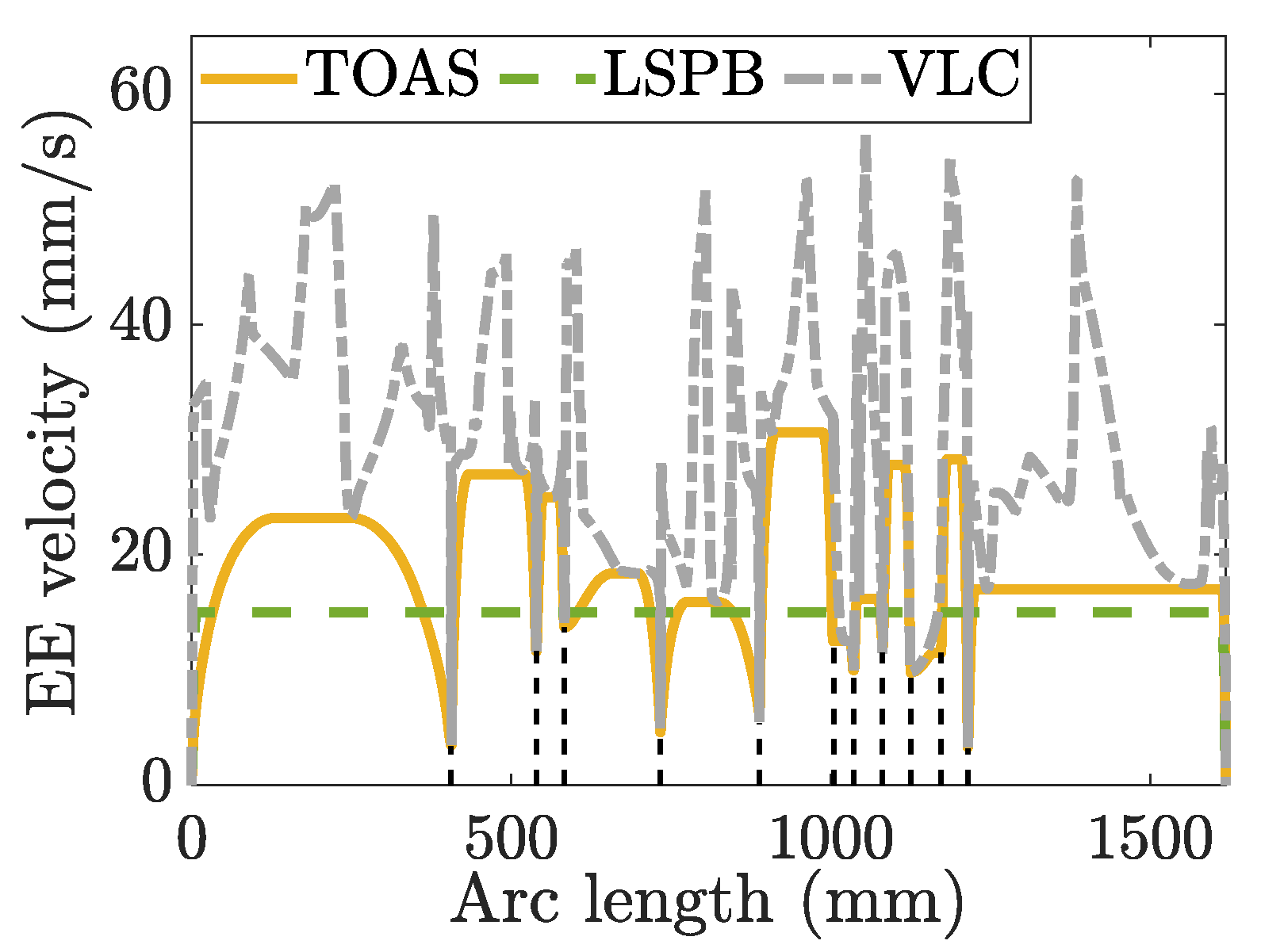
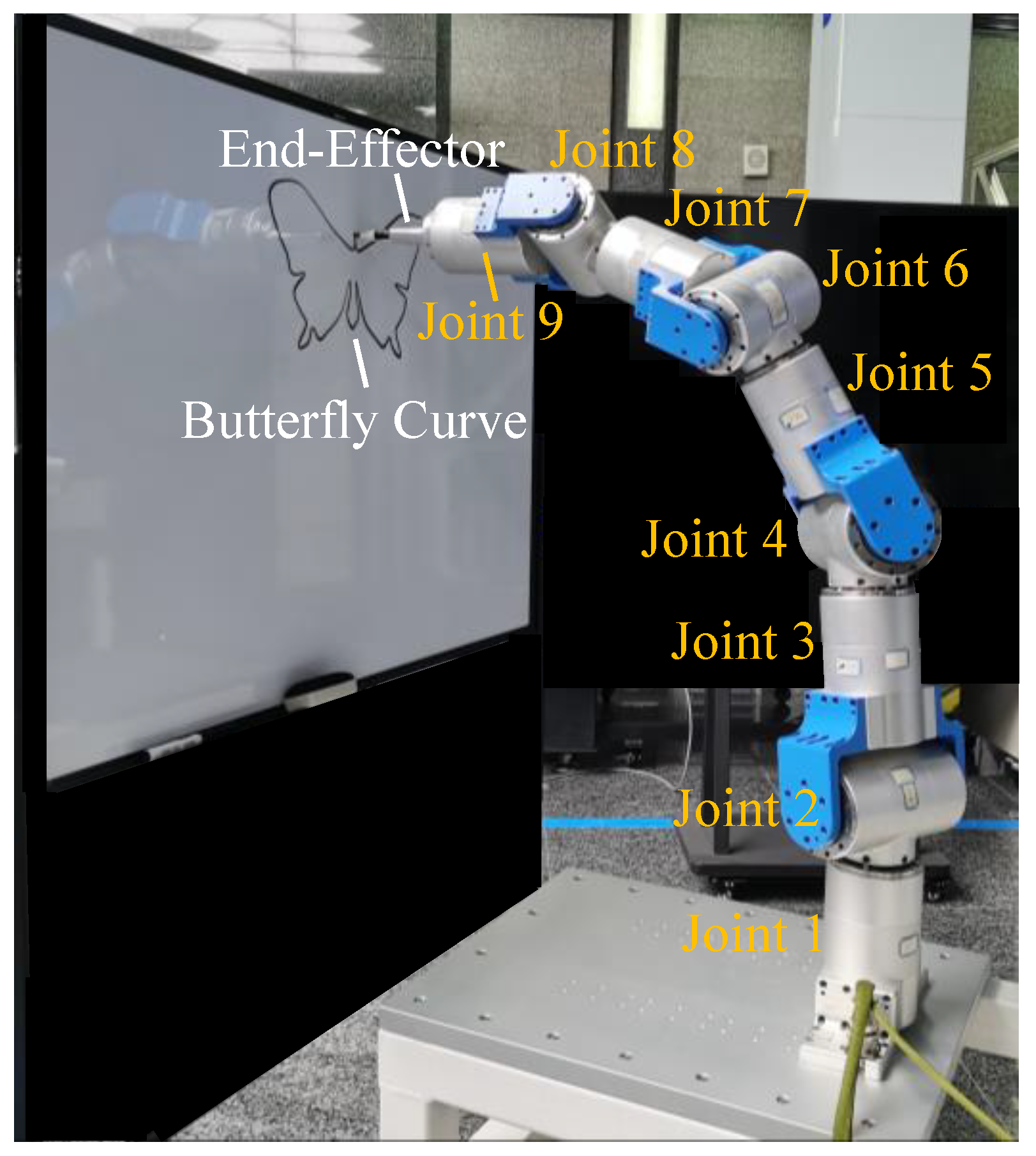
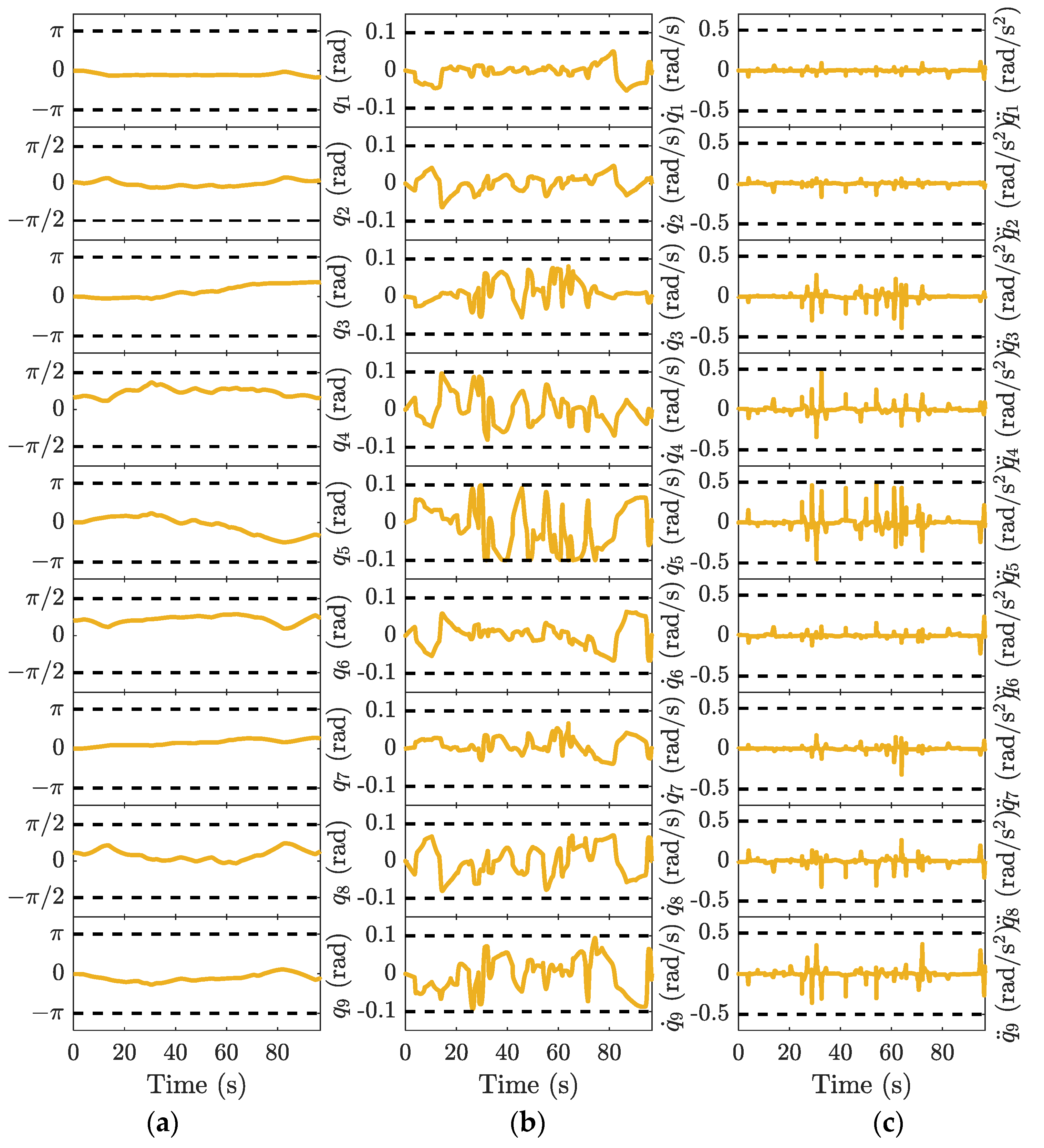
| i | Screw Axis | Configuration at Zero Position | Parameter Values (m) |
|---|---|---|---|
| 1 | |||
| 2 | |||
| 3 | |||
| 4 | |||
| 5 | |||
| 6 | |||
| 7 | |||
| 8 | |||
| 9 |
| Method | TMP | TOAS | BLA | TSS |
|---|---|---|---|---|
| Time (s) | 7.030 | 6.910 | 8.055 | 8.100 |
| Method | TMP | TOAS | BLA | TSS |
|---|---|---|---|---|
| Maximum position errors (m) | 7.67 × 10−3 | 3.53 × 10−4 | 2.29 × 10−4 | 7.08 × 10−4 |
| Mean position errors (m) | 4.25 × 10−4 | 5.37 × 10−5 | 4.44 × 10−5 | 6.23 × 10−5 |
| Method | TMP | TOAS | BLA | TSS |
|---|---|---|---|---|
| Maximum orientation errors (rad) | 9.34 × 10−3 | 7.93 × 10−5 | 7.06 × 10−5 | 1.17 × 10−4 |
| Mean orientation errors (rad) | 6.69 × 10−4 | 2.95 × 10−6 | 1.15 × 10−6 | 8.44 × 10−6 |
| Method | TMP | TOAS | BLA | TSS |
|---|---|---|---|---|
| Mean position errors (m) | 2.82 × 10−2 | 7.92 × 10−4 | 6.38 × 10−4 | 1.21 × 10−3 |
| Mean orientation errors (rad) | 8.13 × 10−3 | 3.24 × 10−4 | 1.75 × 10−4 | 6.67 × 10−4 |
Disclaimer/Publisher’s Note: The statements, opinions and data contained in all publications are solely those of the individual author(s) and contributor(s) and not of MDPI and/or the editor(s). MDPI and/or the editor(s) disclaim responsibility for any injury to people or property resulting from any ideas, methods, instructions or products referred to in the content. |
© 2023 by the authors. Licensee MDPI, Basel, Switzerland. This article is an open access article distributed under the terms and conditions of the Creative Commons Attribution (CC BY) license (https://creativecommons.org/licenses/by/4.0/).
Share and Cite
Liu, T.; Cui, J.; Li, Y.; Gao, S.; Zhu, M.; Chen, L. Time-Optimal Asymmetric S-Curve Trajectory Planning of Redundant Manipulators under Kinematic Constraints. Sensors 2023, 23, 3074. https://doi.org/10.3390/s23063074
Liu T, Cui J, Li Y, Gao S, Zhu M, Chen L. Time-Optimal Asymmetric S-Curve Trajectory Planning of Redundant Manipulators under Kinematic Constraints. Sensors. 2023; 23(6):3074. https://doi.org/10.3390/s23063074
Chicago/Turabian StyleLiu, Tianyu, Jingkai Cui, Yanhui Li, Siyuan Gao, Mingchao Zhu, and Liheng Chen. 2023. "Time-Optimal Asymmetric S-Curve Trajectory Planning of Redundant Manipulators under Kinematic Constraints" Sensors 23, no. 6: 3074. https://doi.org/10.3390/s23063074
APA StyleLiu, T., Cui, J., Li, Y., Gao, S., Zhu, M., & Chen, L. (2023). Time-Optimal Asymmetric S-Curve Trajectory Planning of Redundant Manipulators under Kinematic Constraints. Sensors, 23(6), 3074. https://doi.org/10.3390/s23063074





